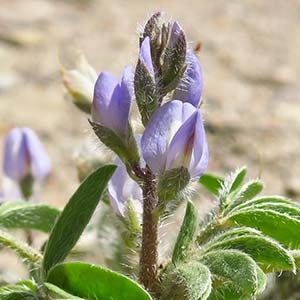Lupinus pusillus
Lupinus arboreus
intermountain lupine, low lupine, rusty lupine
coastal bush lupine, tree lupine, yellow bush lupine
short and tufted or erect, branched from base or near middle.
ascending or erect, branched, woody.
cauline, often crowded near base;
stipules well developed;
petiole 1–9 cm;
leaflets 5–9, blades 10–40 × 5–10 mm, adaxial surface glabrous.
cauline;
stipules 8–12 mm;
petiole 2–3(–6) cm;
leaflets 5–12, blades 20–60 × 3–10 mm, adaxial surface glabrous.
8–12-flowered, 2–11 cm, shorter than or slightly exceeding foliage;
flowers spirally arranged.
10–30 cm;
flowers whorled or not.
0–3.5 cm;
bracts persistent, straight, 2–5 mm.
4–10 cm;
bracts deciduous, 8–10 mm.
1–3.5 mm.
4–10 mm.
5–12 mm;
calyx abaxial lobe entire, 5–6 mm, adaxial lobe cleft, 2.5–4 mm;
corolla vivid blue, sometimes paler or white, sometimes bicolored, banner spot white or yellowish, keel glabrous.
14–18 mm;
calyx bulge or spur 0–1 mm, abaxial lobe entire, 5–7 mm, adaxial lobe 2-toothed, 5–9 mm;
corolla usually yellow, rarely lilac to purple, banner patch darker or not or white, banner glabrous abaxially, lower keel margins glabrous, adaxial margin ciliate from claw to tip.
1.5 cm, constricted between seeds, thinly pilose to coarsely hirsute.
4–7 cm, hairy.
persistent, disclike, sessile.
deciduous, petiolate.
2, wrinkled or ridged.
8–12, black to tan, often striped lighter, 4–5 mm.
= 48.
Lupinus pusillus
Lupinus arboreus
Varieties 3 (3 in the flora).
Lupinus pusillus is a highly variable species, with the varieties intergrading.
(Discussion copyrighted by Flora of North America; reprinted with permission.)
Lupinus arboreus is known from the central California coast southward to northern Baja California; it was introduced as a sand binder and has become naturalized in northern California, Oregon, Washington, and southern British Columbia.
Lupinus arboreus grades into L. rivularis in the North Coast of California. Plants with yellow petals and sweet-smelling flowers are widely cultivated as a sand binder. Hairier plants from the western San Francisco Bay area with yellow banners and blue wings have been called var. eximius; plants with glabrous leaflets and purple petals have been called L. propinquus. Lupinus arboreus hybridizes with L. littoralis and probably other species. Seeds of L. arboreus species are toxic.
(Discussion copyrighted by Flora of North America; reprinted with permission.)
1. Peduncles 0–1 cm; racemes shorter than foliage; flowers 6–8 mm. | var. intermontanus |
1. Peduncles usually 1–3.5 cm; racemes equal to or longer than foliage; flowers 7–12 mm. | → 2 |
2. Pedicels and calyx tubes strigose. | var. pusillus |
2. Pedicels and calyx tubes glabrous. | var. rubens |
- Local floras:
BC,
CA,
OR,
WA
- Local Web sites:
CalFlora,
CalPhotos,
Flora NW,
PNW Herbaria,
Turner Photog.
WildflowerSearch
iNaturalist (observations)
USDA Plants Database
- LBJ Wildflower Center
- SEINet
- Plants of the World Online
- Encyclopedia of Life
- Wikipedia
- Google Image Search
